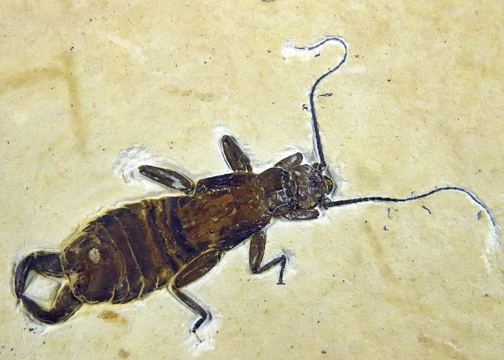Abstract
The Brazilian Crato Formation, located in Araripe Sedimentary Basin, is renowned for its excellent fossil preservation, making it as a significant Cretaceous Konservat-Lagerstätte. Among the diverse groups recorded from this formation, Insecta stands out, boasting over 400 described species, including six species of Dermaptera. This study redescribes Cratoborellia gorbi Haas, a Dermaptera species from Araripe Basin, based on a single, nearly complete and well-preserved male specimen from the Lower Cretaceous Crato Formation, Araripe Basin, Brazil. It adds important morphological characteristics to the taxonomy of the species and distinguishes it from other fossil genera in the region. Opportunity is taken to report an additional specimen of the very rare Caririlabia berghoffi Hass, previously known only from the holotype.
References
- Arai, M., Carvalho, I.S. & Cassab, R.C.T. (2004) Araripe Basin. Phoenix, 6 (72), 1–6.
- Bezerra, F.I. & Mendes, M. (2024) A palaeoecological analysis of the Cretaceous (Aptian) insect fauna of the Crato Formation, Brazil. Palaeogeography, Palaeoclimatology, Palaeoecology, 641, 112–134. https://doi.org/10.1016/j.palaeo.2024.112134
- Carle, F.L. & Wighton, D.C. (1990) Odonata. In: Grimaldi, D.A. (Ed.), Insects from the Santana Formation, Lower Cretaceous, of Brazil. Bulletin of the American Museum of Natural History, 195, 51–68.
- Catto, B., Jahnert, R.J., Warren, L.V., Varejao, F.G. & Assine, M.L. (2016) The microbial nature of laminated limestones: Lessons from the Upper Aptian, Araripe Basin, Brazil. Sedimentary Geology, 341, 304–315. https://doi.org/10.1016/j.sedgeo.2016.05.007
- Chatzimanolis, S. & Engel, M.S. (2010) Laasbium Scudder: A genus of Tertiary earwigs, not rove beetles, and the classification of Florissant fossil Dermaptera (Insecta). Annales Zoologici, 60 (1), 101–108. https://doi.org/10.3161/000345410X499588
- de Geer, C. (1773) Mémoires pour servir à l’Histoire des Insectes I. Orthoptères vol. 3. 696 pp.
- Engel, M.S. (2003) The earwigs of Kansas, with a key to genera north of Mexico (Insecta: Dermaptera). Transactions of the Kansas Academy of Science, 106 (3), 115–123. https://doi.org/10.1660/0022-8443(2003)106[0115:TEOKWA]2.0.CO;2
- Engel, M.S. & Chatzimanolis, S. (2005) Early Cretaceous earwigs (Dermaptera) from the Santana Formation, Brazil. Polskie Pismo Entomologiczne, 74, 219–226.
- Engel, M.S. & Haas, F. (2007) Family-group names for earwigs (Dermaptera). American Museum Novitates, 2007 (3567), 1–20. https://doi.org/10.1206/0003-0082(2007)539[1:FNFED]2.0.CO;2
- Freitas, L.C., Moura, G.J.D. & Saraiva, A.A.F. (2016) First occurrence and paleo-ecological implications of insects (Orthoptera: Ensifera Gryllidae) in the Romualdo Member of the Santana Formation, Eo-Cretaceous of the Araripe Basin. Anais da Academia Brasileira de Ciências, 88 (4), 2113–2120. https://doi.org/10.1590/0001-3765201620150375
- Grimaldi, D. & Engel, M.S. (2005) Evolution of the insects. Cambridge University Press, New York, 755 pp.
- Haas F. (2007) Dermaptera: earwigs. In: Martill D.M., Bechly G. & Loveridge, R.F. (Eds), The Crato fossil beds of Brazil: Window into an ancient world. Cambridge University Press, Cambridge, pp. 222–234.
- Haas, F., Hwen, J.T.C. & Tang, H. (2012) New evidence on the mechanics of wing unfolding in Dermaptera (Insecta). Arthropod Systematics & Phylogeny, 70, 95–105. https://doi.org/10.3897/asp.70.e31752
- Heimhofer, U., Ariztegui, D., Lenniger, M., Hesselbo, S.P., Martill, D.M. & Rios-Netto, A.M. (2010) Deciphering the depositional environment of the laminated Crato fossil beds (Early Cretaceous, Araripe Basin, North-eastern Brazil). Sedimentology, 57 (2), 677–694. https://doi.org/10.1111/j.1365-3091.2009.01114.x
- Heleodoro, R.A. (2024) Chapter 17: Dermaptera De Geer, 1773. Insects of Brazil: Diversity and Taxonomy. 2nd ed, 239–248. https://doi.org/10.61818/56330464c17
- Maisey, J.G. (1991) Santana fossils: an illustrated atlas. T.F.H. Publications, Neptune City, New Jersey, 459 pp.
- Mao, Y., Engel, M.S., Zhao, Y. & Ren, D. (2020) A new genus of labidurid earwigs in mid-Cretaceous amber from northern Myanmar (Dermaptera: Labiduridae). Cretaceous Research, 111, 104447. https://doi.org/10.1016/j.cretres.2020.104447
- Martill, D.M., Bechly, G. & Loveridge, R.F. (2007) The Crato fossil beds of Brazil: window into an ancient world. Cambridge University Press, Cambridge, New York, 624 pp. https://doi.org/10.1017/CBO9780511535512
- Martins-Neto, R.G. (1990) First record of Dermaptera (Insecta, Orthopteromorpha) in the Santana Formation (Lower Cretaceous), Araripe Basin, Northeastern Brazil. Brazilian Journal of Entomology, 34 (4), 775–784.
- Moura-Júnior, D.A., Scheffler, S.M. & Fernandes, A.C.S. (2018) Brazilian paleoentomofauna: current scenario. Anuário IGEO UFRJ, 41, 142–166. https://doi.org/10.11137/2018_1_142_166
- Nudds, J. & Selden, P. (2008) Fossil-Lagerstätten. Geology Today, 24 (4), 153–158. https://doi.org/10.1111/j.1365-2451.2008.00679.x
- Peng, A., Engel, M.S., Zhuo, D. & Nel, A. (2024) A new labiduroid earwig from mid-Cretaceous Kachin amber (Dermaptera: Labiduroidea). Cretaceous Research, 166, 105994. https://doi.org/10.1016/j.cretres.2024.105994
- Popham, E.J. (1990) Dermaptera. In: Grimaldi, D.A. (Ed.), Insects from the Santana Formation, Lower Cretaceous, of Brazil. Bulletin of the American Museum of Natural History, 195, 69–75.
- Saraiva, A.A.F., Hessel, M.H., Guerra, N.C. & Fara, E. (2007) Limestone concretions from the Santana Formation, Araripe Basin: a classification proposal. Geological Studies, 17 (1), 40–57.
- Saraiva, A.A.F., Lima, F.J., Barros, O.A. & Bantim, R.A.M. (2021) Araripe Basin Fossil Guide. 1st ed. Crato, Brazil, 378 pp.
- Verhoeff, K.W. (1902a) Über Dermapteren. 1. Aufsatz. Versuch eines neuen, natürlichen Systems auf vergleichend-morphologischer Grundlage und über den Mikrothorax der Insecten. Zoologischer Anzeiger, 25, 181–209. http://www.biodiversitylibrary.org/item/37981#page/195/
- Verhoeff, K. (1902b) Über Dermapteren. 2. Aufsatz: Neue ungeflügelte Eudermapteren-Gattungen. Sitzungsberichte der Gesellschaft Naturforschender Freunde zu Berlin, 1902 (1), 2–18. http://digitallibrary.amnh.org/
- Wang, J.L., Engel, M.S., Shih, C.K. & Ren, D. (2022) A new earwig species of Stonychopygia from mid-Cretaceous Kachin amber (Dermaptera: Pygidicranidae). Cretaceous Research, 142, 105382. https://doi.org/10.1016/j.cretres.2022.105382
- Wappler, T., Engel, M.S. & Haas, F. (2005) The earwigs (Dermaptera: Forficulidae) from the middle Eocene Eckfeld maar, Germany. Polskie Pismo Entomologiczne, 74 (3), 227–250.
- Warren, L.V., Varejão, F.G., Quaglio, F., Simões, M.G., Fürsich, F.T., Poiré, D.G., Catto, B. & Assine, M.L. (2017) Stromatolites from the Aptian Crato Formation, a hypersaline lake system in the Araripe Basin, northeastern Brazil. Facies, 63, 1–19. https://doi.org/10.1007/s10347-016-0484-6
- Yang, D., Shih, C.K. & Ren, D. (2014) The earliest pygidicranid (Insecta: Dermaptera) from the Lower Cretaceous of China. Cretaceous Research, 52, 329–335. https://doi.org/10.1016/j.cretres.2014.03.008
- Zhao, J.X., Zhao, Y.Y., Shih, C.K., Ren, D. & Wang, Y.J. (2010) Transitional fossil earwigs—a missing link in Dermaptera evolution. BMC Evolutionary Biology, 10, 1–10. https://doi.org/10.1186/1471-2148-10-344


